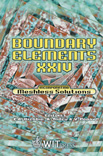Hierarchical Plate Modelling By Boundary Elements
Price
Free (open access)
Transaction
Volume
32
Pages
14
Published
2002
Size
564 kb
Paper DOI
10.2495/BE020181
Copyright
WIT Press
Author(s)
T Westphal Jr & E Schnack
Abstract
We obtain a hierarchical formulation for the differential and integral equations of the twelfth-order plate bending model for homogeneous transversely isotropic materials (Poniatovskii [l], Reissner [2]). The hierarchical specification means that the direct reduction from the twelfth-order equation system furnishes corresponding systems of lower-order: a) the systems of sixth-order of Reissner [3]and Mindlin [4],and b) the system of fourth-order of Kirchhoff. By means of the selection of particular values of two coupling coefficients we obtain the sixth-order system of Reissner. The sixth-order system of Mindlin and the fourth-order system of Kirchhoff are included in the hierarchy by using the tensors of Westphal Jr. et al. [5]. The differential equations for the twelfth-order model are obtained by application of the Hellinger-Reissner mixed variational principle. We show that the system of differential equations gives a best approximation to the three-dimensional elasticity equations (Lur’e [6]) than displacement-based models (Schwab & L Wright [7]).The hierarchical reduction of the twelfth-order integral equations furnishes the well known sixth-order equations of van der Weeen [8]. With the corresponding fundamental solutions the BEM can consequently be used to solve the hierarchy of problems.
Keywords





